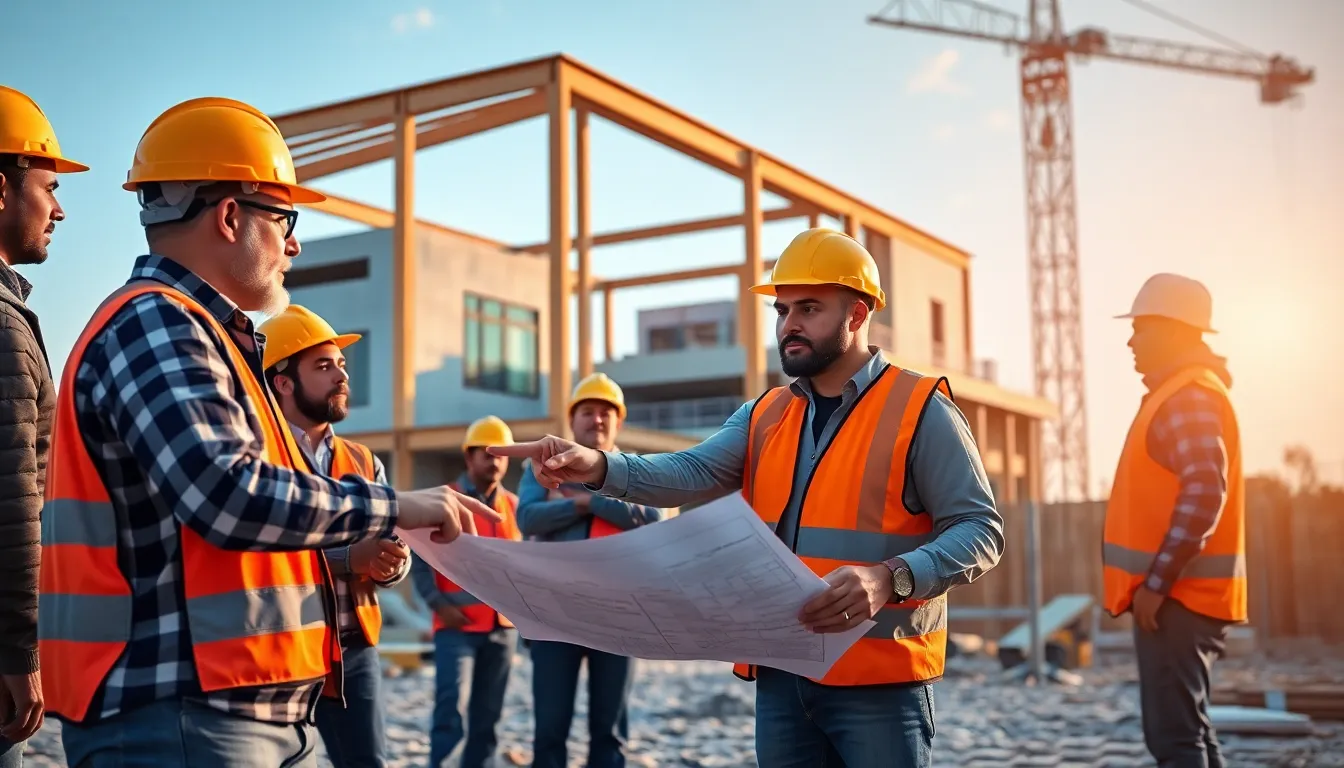Table of Contents
ToggleBuilding isn’t just about bricks and mortar; it’s a blend of creativity, strategy, and a sprinkle of chaos. Whether it’s crafting a cozy home or erecting a towering skyscraper, the process can be as thrilling as a rollercoaster ride—minus the safety harness. Each project tells a story, showcasing the vision, effort, and occasional mishaps that come with it.
In a world where DIY shows make construction look easy, the reality often involves more than just hammering nails. From selecting the right materials to navigating zoning laws, building requires a mix of savvy planning and a dash of humor. So, buckle up and prepare to dive into the fascinating world of construction, where every nail driven and wall raised brings dreams to life, one hilarious mishap at a time.
Overview of Building
Building encompasses much more than physical construction. It combines creativity and strategic planning while navigating complex regulations. Projects include everything from residential homes to towering skyscrapers. Various components require careful consideration, including material selection and compliance with zoning regulations.
Materials play a crucial role in the durability and aesthetics of a structure. Common options include wood, steel, concrete, and glass. Each material brings unique benefits and challenges, impacting the overall design and function. Additionally, sustainability increasingly influences material choices, with eco-friendly options gaining popularity.
Planning is essential to successful building ventures. Project managers outline timelines, budgets, and resource allocations. They coordinate with contractors, architects, and engineers, ensuring alignment at each project stage. Effective communication among teams helps prevent costly delays and misunderstandings.
The design process, often collaborative, involves multiple stakeholders. Architects create blueprints, engineers assess structural integrity, and interior designers enhance living spaces. Integrating diverse perspectives fosters innovation and ensures functionality.
Challenges accompany every building project. Weather conditions, unexpected site conditions, and regulatory changes can arise. Mitigating these obstacles requires adaptability and problem-solving skills. Managing resources effectively contributes to overcoming these hurdles.
Ultimately, building represents a dynamic journey. Each project reflects the collective effort of skilled professionals and visionaries. Observing the evolution from concept to completion offers insight into the intricate world of construction.
Types of Building

Building encompasses several types, each serving distinct purposes and requirements. The primary categories include residential, commercial, and industrial buildings.
Residential Buildings
Residential buildings are designed for individuals and families. These structures include single-family homes, multi-family units, and apartment complexes. Each type offers unique features, catering to various lifestyles and needs. For example, single-family homes provide privacy and outdoor space, while apartments often offer shared amenities and lower maintenance. The demand for sustainability in residential construction is rising, leading to green building techniques and energy-efficient materials.
Commercial Buildings
Commercial buildings serve businesses and organizations. Shopping centers, office spaces, and hotels form the backbone of this sector. Each structure aims to facilitate business operations and enhance customer experiences. Large retail spaces require open layouts and efficient traffic flow, whereas office buildings often prioritize functionality and comfort. Recent trends emphasize flexibility, enabling companies to adapt spaces for changing business needs while incorporating eco-friendly designs to meet sustainability goals.
Industrial Buildings
Industrial buildings support manufacturing and logistics activities. Factories, warehouses, and distribution centers fall under this category. Each building type addresses specific operational requirements, including loading docks, equipment access, and safety regulations. Factories often contain specialized machinery, while warehouses prioritize storage efficiency. Innovation drives industrial building designs, focusing on automation and reducing environmental impact through energy-efficient systems. These facilities are critical for supply chain management and economic productivity.
Building Materials
Building materials play a crucial role in the construction process, impacting both function and aesthetics. Choices range from traditional to sustainable options, each offering distinct advantages.
Sustainable Materials
Sustainable materials prioritize eco-friendliness and energy efficiency. Bamboo represents a highly renewable resource known for its strength. Recycled steel reduces waste and delivers durability. Additionally, reclaimed wood adds character while minimizing deforestation. Other options include concrete with recycled aggregates and low-VOC (volatile organic compound) paints that promote indoor air quality. The trend toward green building reflects increasing demand for sustainable living solutions, aligning construction practices with environmental responsibility.
Traditional Materials
Traditional materials have long been the backbone of construction. Wood has offered warmth and versatility for residential and commercial structures alike. Brick provides durability and excellent insulation, suitable for various climates. Stone, known for its longevity, lends a classic aesthetic to buildings. Concrete remains a strong choice for foundations and structural elements due to its load-bearing capabilities. Each of these materials continues to meet the structural and aesthetic demands of diverse building projects, highlighting their essential roles in modern construction.
Building Techniques
Building techniques encompass a variety of methods tailored to enhance efficiency and effectiveness in construction projects. These methods fall into modern and traditional categories, each holding distinct advantages.
Modern Construction Methods
Modern construction methods emphasize technology and innovation. Prefabrication allows components to be manufactured off-site, reducing on-site labor and speeding up project timelines. Modular construction further enhances efficiency by enabling entire sections of buildings to be constructed in factories. 3D printing technology is gaining traction for its ability to create complex structures with minimal waste. Smart building systems integrate IoT devices for better energy management and automated controls, optimizing operational costs. These advances reflect a trend toward sustainability and responsiveness in meeting modern needs.
Traditional Construction Techniques
Traditional construction techniques focus on time-tested practices. Masonry involves laying bricks or stones to create sturdy walls, often utilized in residential buildings. Timber framing uses wooden beams, providing flexibility and a natural aesthetic. Concrete pouring remains a staple for foundations, offering strength and durability. These methods promote craftsmanship and local materials, reflecting the character of their environments. Even with modern advancements, these classical techniques maintain relevance, especially in areas prioritizing cultural heritage and authenticity in construction.
Building Regulations
Building regulations ensure the safety and quality of construction projects. They establish standards that professionals must adhere to throughout the building process.
Safety Standards
Safety standards play a crucial role in protecting occupants and workers. These standards encompass regulations regarding structural integrity, fire safety, electrical systems, and plumbing systems. An example includes the International Building Code (IBC), which sets guidelines for constructing safe structures. Professionals must also consider local safety codes, as these can vary significantly from one jurisdiction to another. Non-compliance with safety standards can result in severe penalties, including fines or project delays. Adhering to these regulations fosters a culture of safety, ultimately protecting lives and property.
Zoning Laws
Zoning laws dictate how land can be used within certain areas. These laws help manage urban development by outlining what types of buildings can occupy specific zones. For instance, residential areas typically restrict commercial activities to preserve neighborhood character. The implementation of zoning laws can prevent overcrowding and ensure adequate public services and infrastructure. Variances to these regulations may be sought by developers for unique projects, requiring careful consideration by local authorities. Understanding zoning laws is essential for anyone involved in planning or construction, as they can significantly impact project feasibility and timelines.
Building is a dynamic journey that intertwines creativity with strategy. It showcases the collaboration of skilled professionals who navigate challenges and celebrate successes throughout the construction process. The choices made in materials and techniques not only affect the structure’s functionality but also its environmental impact.
As the industry evolves, the emphasis on sustainability and innovative methods continues to shape the future of construction. Understanding the complexities of building regulations and zoning laws is crucial for anyone involved in this field. Ultimately, the art of building reflects society’s needs and aspirations, making it an exciting and ever-changing domain.




